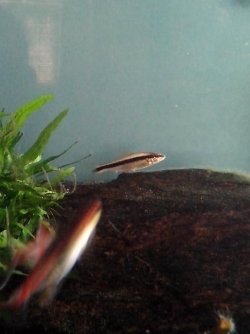I must admit that the differences between those two species in the photos on SF are difficult to distinguish, as Ch4rlie mentions. Seen in a store tank, I would not know which was which unless both were there, and perhaps not even then. We also don't know how the lighting in the two photos may affect the colour.
There are presently 20 valid described species in the genus Crossocheilus, as listed by Dr. Eschmeyer in the authoritative ichthyological catalogue database of CAS. Now, this does not mean they are all going to appear in the hobby; they all occur in SE Asia, though from different areas at least in some cases (as far as I know, I am not going to track each one down).
Akasha, it is extremely unlikely that you have C. siamensis, as I explained earlier; this species is not even a valid one now, as the name is a synonym for C. oblongus the correct species, and as Matt Ford mentions in the SF profile of C. langei, "It [meaning, C. oblongus] was described as a blueish fish with yellow fins and is almost certainly not the ‘SAE’ in the aquarium hobby." I would venture that you and others who have the "SAE" almost certainly have C. langei if it appears according to the description we have been tossing around. Though having said that, as all these fish are imports from the wild, it is increasingly possible that other species are being collected and as Ch4rlie said the names are frequently inaccurate unless the collector has sufficient ichthyological knowledge to know the differences. Of course, if the species are in separate populations and not overlapping, it is much easier to determine the correct species from the locale it comes from.
Byron.





